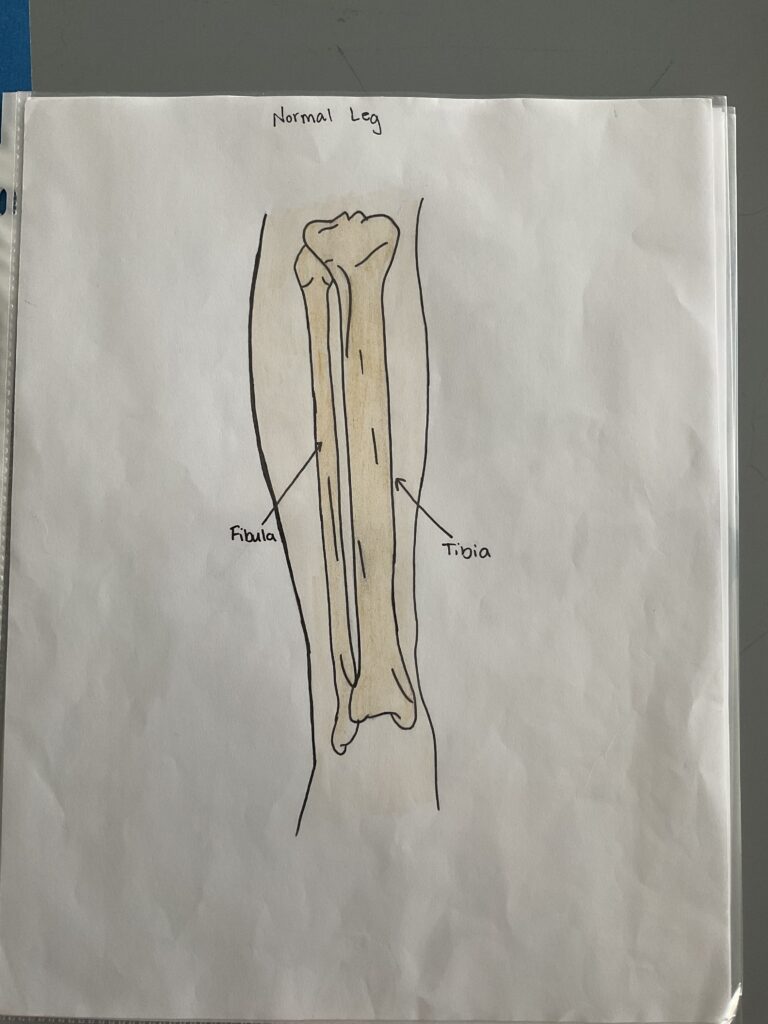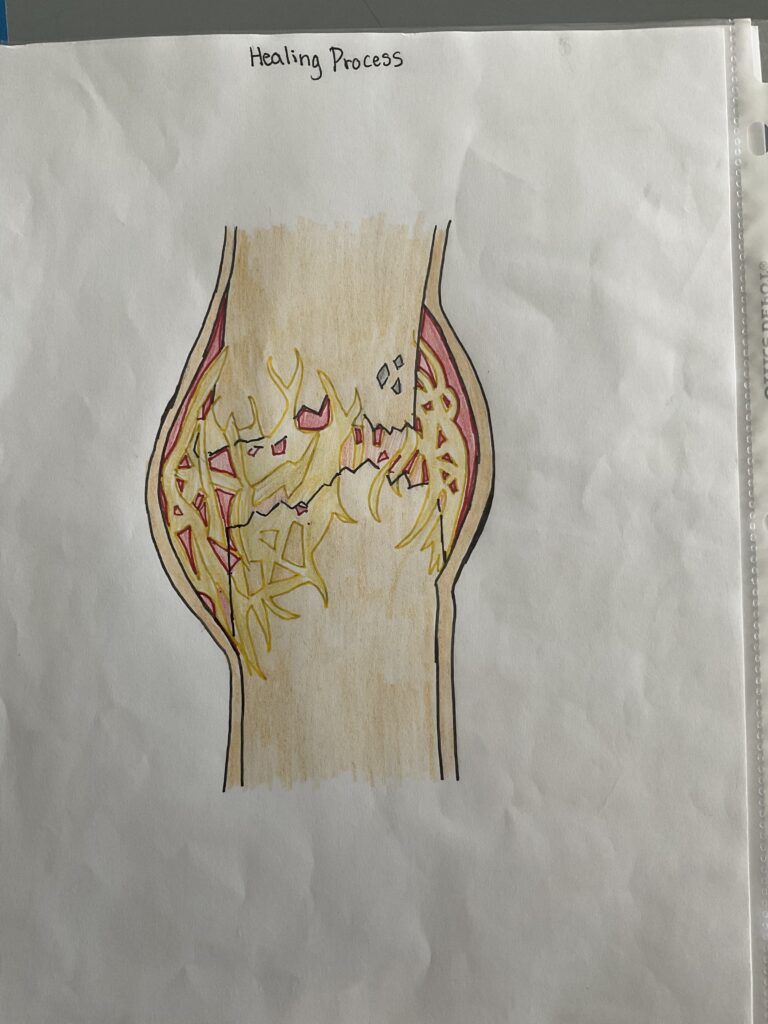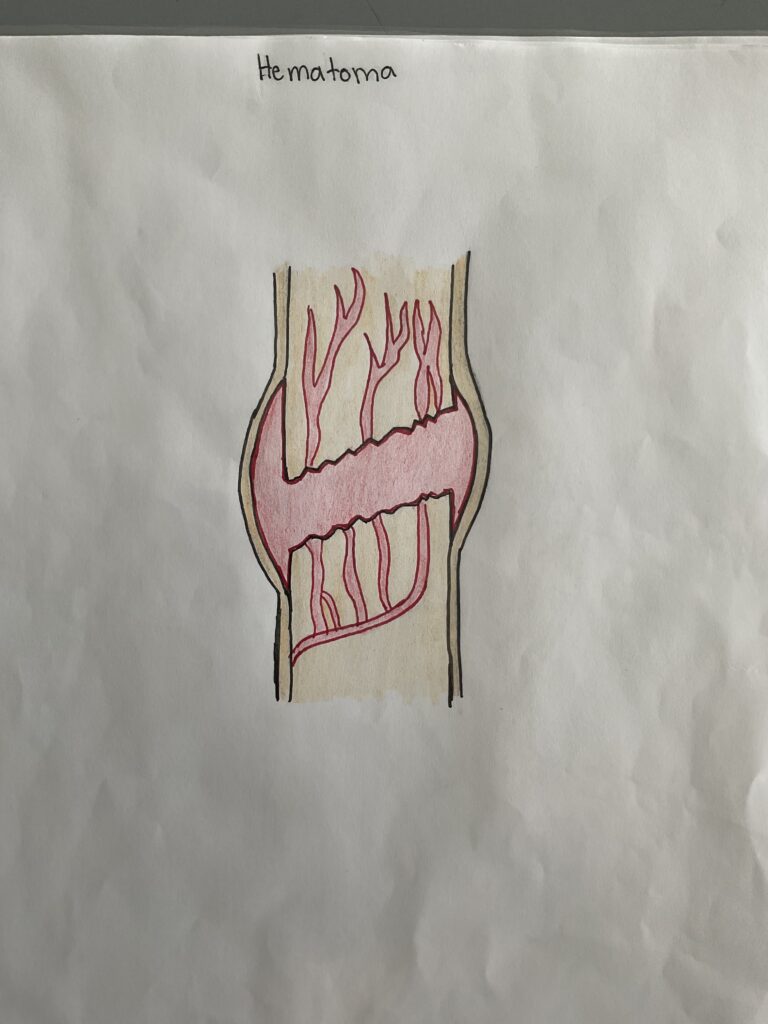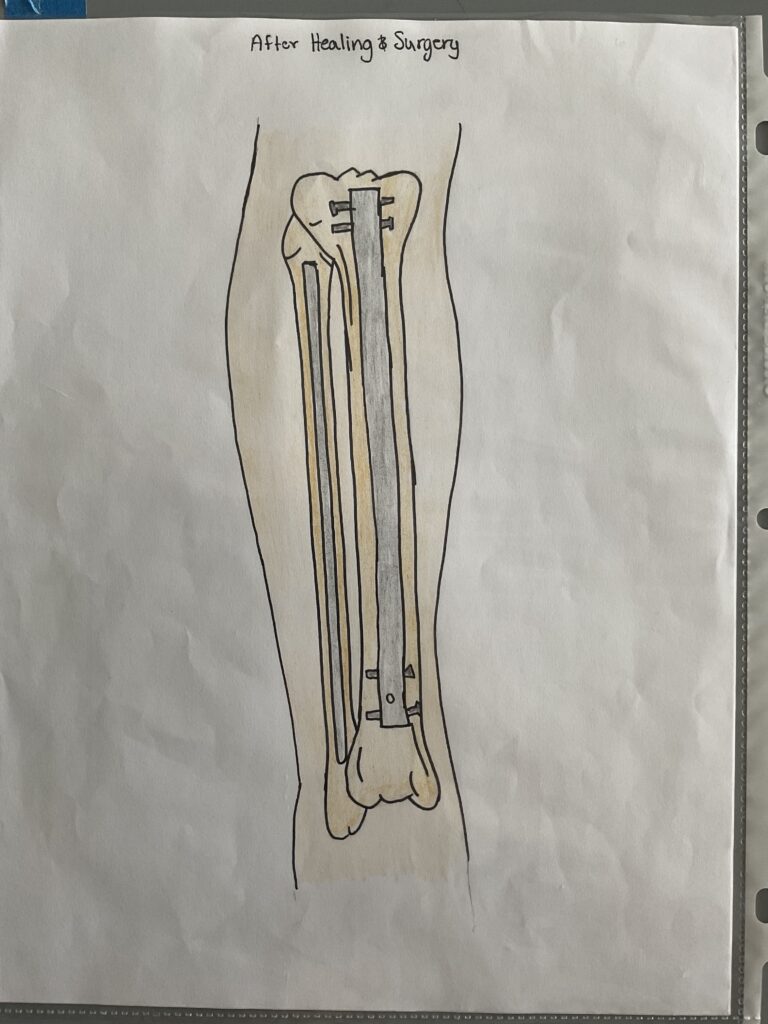The objective of this project I am covering is to classify certain fractures; specifically the compound fracture. I will also talk about the healing process of the bone based on the specific types of metals being used to fix the bone. There are many common types of fractures: compressed, spiral, epiphyseal, depressed, green stick, comminuted, staple, transverse, oblique, and of course the compound fracture. The media that I did for my project was a drawing of a normal tibia and fibula, the bones as broken compound fracture, the hematoma within the leg, the healing process of the bone, and finally the fixation of the bone with metal plates and the end result.
The way a compound fracture usually occurs is when there is a serious injury or trauma happens. The bone pierces through the skin or goes through it. The healing process of the tibia and fibula are very long. If the bones aren’t precisely aligned properly, there could be major damage within the leg. To fix the bones for proper healing, surgery is required with the use of metal plates, screws, or rods (Ganesh et.al, 2005). The plates that are required for proper fixation are stainless steel plates or stiffness graded plates (Ganesh et.al, 2005). Stiffness-grade plates are known for helping the bone heal with less stress off the bone (Ganesh et.al, 2005). This allows the bone to be more stable and bend less. I also found out that it makes the healing process a lot quicker. The type of materials used for the plater are; stainless steel, cobalt base alloys, bio ceramics, titanium alloys, pure titanium, composite materials and polymers (Ganesh et.al, 2005). Stiffness graded plates are known for their ability to help the bone take on less stress which provide better healing (Ganesh et.al, 2005). Some factors towards this type of metal being used are; the type of fracture that has occurred, providing stability towards the bone to decrease the movement of the fracture, and the stress taking ability towards the bone to ensure quicker healing (Ganesh et.al, 2005).
The healing process of this type of fracture depends on the type of fracture that is present. When the bone is broken, it forms a hematoma, which is the stage that happens once the bone is broken. This happens because it is the body’s way of preparing to start the healing process (Sheen & Garla, 2022). As this occurs, it creates clots and starts to create a temporary frame for proper healing (Sheen & Garla, 2022). This process takes about one to five days. After the hematoma happens, the Fibrocartilaginous callus process begins to happen. This is where the bone is slowly starting to heal. Once the vascular endothelial growth factor happens, this ensures that the body will actually create tissue to make the repair (Sheen & Garla, 2022). Cells collect together, fibroblast, chondroblast, and osteoblast sort through the blood cells, and as a result of this, a collagen-rich Fibrocartilage sleeve develops (Sheen & Garla, 2022). Next, the layers slowly begin to gather together. This process happens within five to eleven days. The next process of bone healing is the bony callus formation. This step begins when the cartilaginous callus begins to go through a process called endochondral ossification (Sheen & Garla, 2022). This phrase or expression, RANKL, is the more stimulation to decipher the chondroblast, chondroclasts, osteoblasts, and osteoblasts(Sheen & Garla, 2022). New created blood cells continue to heal the bone, and this is when the bone starts to form together again. This process takes eleven to twenty-eight days. Finally, the last step within the process is the bone completes the healing. At this point, the bone has then regenerated back to the normal bone state. However, it will continue healing for several months, and could even take up to a year (Sheen & Garla, 2022).
In conclusion, the project that I researched was to discover the type of metal generally used to repair a compound fracture with the tibia and fibula. The type of metal that is the most useful is the stiff-ness grade plate which helps the bone with stability, a quicker healing time, and less stress on the compromised bones. I also learned about the healing process and how long it may take for a compound fracture to fully heal. The type of project representation I did was a drawing, showing what this whole process looks like.






References
Ganesh, V. K., Ramakrishna, K., & Ghista, D. N. (2005, July 27). Biomechanics of bone-fracture fixation by stiffness-graded plates in comparison with stainless-steel plates – biomedical engineering online. BioMed Central. Retrieved June 29, 2022, from https://biomedical-engineering-online.biomedcentral.com/articles/10.1186/1475-925X-4-46
Lowe, J. A. (2019, April). Internal fixation for fractures – orthoinfo – aaos. OrthoInfo. Retrieved June 29, 2022, from https://orthoinfo.aaos.org/en/treatment/internal-fixation-for-fractures/
Sheen, J. R., & Garla, V. V. (2022). Fracture healing overview – statpearls – NCBI bookshelf. National Library Of Medicine. Retrieved July 1, 2022, from https://www.ncbi.nlm.nih.gov/books/NBK551678/

The healing process of the compound fracture in metal plates happens when there is a severe injury. One injury could be when the bone goes through the skin. This would require surgery using metal screws, plates or rods. The two plates that are important for proper fixation are stainless steel plates and stiffness graded plates. Stiffness-grade plates help the bone heal with less stress. Providing for more stability, bend less and faster healing. The materials used for the plater are stainless steel, cobalt base alloys, bio ceramics, titanium alloys, pure titanium and composite materials. These materials provide stability towards the bone to decrease the movement of the fracture.
Now, the healing process when the bone is broken forms a hematoma. Hematoma generates clots and starts to create a temporary frame for proper healing which takes up to one to five days. Next, the fibrocartilaginous callus begins to start. Where the bone is healing. Now when the vascular endothelial growth factor occurs, to restore the body will create tissue. Third, the layers will come together, taking about five to eleven days. Fourth, bony callus formation, when cartilaginous callus goes through endochondral ossification. Then RANKL, is when there is more ecipher the chondroblast, chondroclasts, osteoblasts, and osteoclasts. Creating more blood cells allows the bone to heal and form together again. This takes about eleven to twenty-eight days. The last step means the bone has gone back to the normal bone state but it will continue to heal for a few months to a year.